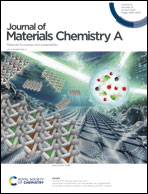Synergistic electronic structure modulation of Pt using V2O3 and V8C7 for enhanced deuterium evolution performance†
Abstract
The slower kinetics of the deuterium evolution reaction (DER) than the hydrogen evolution reaction (HER) renders conventional Pt-based HER catalysts inefficient in the DER. Their further improvement requires precise tuning of intermediate adsorption energy which is already near optimum on pure Pt. Herein, we achieved superior DER/HER performance by combining Pt and a dual support system consisting of V2O3 and V8C7 that exert different electronic effects on Pt. In 1 M NaOD (NaOH) and 0.5 M D2SO4 (H2SO4), the optimal Pt/V2O3/V8C7 catalyst exhibited low overpotentials of 37 mV (15 mV) and 49 mV (45 mV) at a current density of 10 mA cm−2, respectively. Its mass activity based on the amount of Pt was up to 9 times higher than that of commercial Pt/C, leading to a reduction of cell voltage by 0.5 V in PEM electrolysis of D2O at 1000 mA cm−2. X-ray photoelectron spectroscopy and underpotential H deposition showed that electron-withdrawing effects of V2O3 over-weakened intermediate adsorption on Pt/V2O3 while Pt/V8C7 had insufficient metal–support interaction of such kind. A balanced effect was only achieved with the dual support system, which accounts for the excellent performance of Pt/V2O3/V8C7. This study provides a new perspective on the modulation of metal–support interaction in Pt-based electrocatalysts and demonstrates potential application of the Pt/V2O3/V8C7 in industrial production of D2.

- This article is part of the themed collections: Frontiers in electrocatalysis for clean energy and 2024 Journal of Materials Chemistry A HOT Papers


 Please wait while we load your content...
Please wait while we load your content...